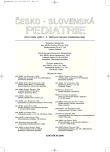Primary Disorders of Lipid Metabolism in Children – Our Experience
Authors:
L. Dostalová Kopečná
Authors‘ workplace:
I. dětská interní klinika LF MU a FN Brno
přednostka prof. MUDr. H. Hrstková, CSc.
Published in:
Čes-slov Pediat 2006; 61 (9): 506-512.
Category:
Original Papers
Overview
Introduction:
In the years 1996–2005 authors have examined in their our outpatient department 697 children (350 boys and 347 girls) sent to them in relation of dyslipoproteinemia (DLP) by general practitioners for children and adolescents.
Materials and methods:
In these patients were followed total cholesterol (TC), LDL, HDL, and triacylglycerols (TAG). The diagnosis of primary DLP was confirmed by molecular genetic methods in 59 children (27 boys, 32 girls). Familial hypercholesterolemia was demonstrated in 12 patients (5 boys and 7 girls) at the average age of 14.7 years. The mutations R395W, D461N, G571E and D245E proved to be most frequent. Familial defect of apolipoprotein B-100 was demonstrated in 47 children (22 boys, 25 girls) with values after 6 months of adhering to the diet.
Results:
The statistical analysis revealed that the levels of TC in children after dietary treatment decreased significantly in comparison with the starting values, the decrease being 13%. The decrease of LDL levels was also statistically significant, reaching values 12% lower than the starting ones. In 8 children treated by diet and also by hypolipidemic drugs (Sortis, Questran), their TC, TAG, HDL, and LDL levels before the therapy, on the diet and after 6 months of combined treatment were compared. Statistical analysis demonstrated that the combined therapy significantly decreased the levels of serum TC by more than 55%. The combined therapy also resulted in a statistically significant decreased in the levels of serum LDL (p <0.05). The decrease was by about 57%.
Conclusions:
In most children with DLP the adjustment of nutritional and physical habits is sufficient to return the lipid concentrations to normal levels. Children often maintain their unfavorable habits and carry out such risk into adulthood. Indications for initiation of pharmacological therapy are strictly individual and require observation by a specialist.
Key words:
children, familial hypercholesterolemia, familial defect of apolipoprotein B-100, hypolipidemic therapy, prevention
Labels
Neonatology Paediatrics General practitioner for children and adolescentsArticle was published in
Czech-Slovak Pediatrics

2006 Issue 9
Most read in this issue
- Primary Disorders of Lipid Metabolism in Children – Our Experience
- Does Artificial Suckling Nutrition Pose a Risk of Atherosclerosis at the Adult Age?
- National Cholesterol Program in Children’s Population in Slovakia and Its Contribution
- Food Supplements with Fish Oils – The Composition of Fatty Acids
